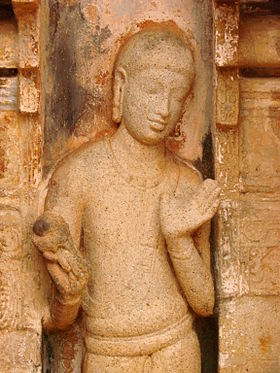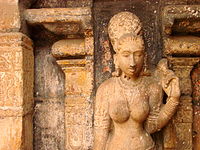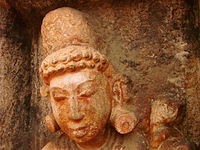- Nageswaran Temple, Kumbakonam
-
Nageswaran Temple Location in Tamil NaduCoordinates: 10°59′N 79°22′E / 10.983°N 79.367°ECoordinates: 10°59′N 79°22′E / 10.983°N 79.367°E Name Other names: Kudanthai Keezhakottam Location Country: India State: Tamil Nadu District: Tanjore Location: Kumbakonam Temple Details Primary Deity: Nageswaran(Shiva) Temple Tank: Surya Theertham Appeared For: Vanni Architecture and culture Architectural styles: Dravidian architecture Nageswaran Temple is a Hindu temple dedicated to Lord Shiva located in Kumbakonam, Tamilnadu, India[1]. The temple is incarnated by the hymns of Thevaram and is classifed as Paadal Petra Sthalam. Shiva in the guise of Nagaraja, the serpent king and is located in the centre of Kumbakonam.
Contents
The Stately Temple
Aditya Chola constructed this temple during the 12th century. It is great marvel of Chola architecture, building technology and astronomy. The orientation is structured in such a way that it allows sunlight inside the temple, right on the sanctum only during the Tamil month of Chithirai (April/May). It bears another name called Surya Kottam or Keezha Kottam. The Karuvarai(Sanctum Sanctorum) of Nageswaran temple is similar to Sarangapani Temple, as it is made in the form of a Chariot. The temple consists of three gopurams in the eastern, western and southern directions.
Legend
This vast temple known is for its shrine of Rahu, one of the nine celestial bodies in the Navagrahas. A legend has it that the mythological serpents Adiseshan, Dakshan and Kaarkotakan worshipped Lord Shiva here. Legend also has it that King Nala worshipped Shiva here as in Thirunallar. There is a Naganathar temple at Tirunageswaram having similar features like temple.
This place has been referred in thevaram written by Saint Tamil poet of 7th Century AD, Thirugnana Sambanthar.[2]
Architecture
The temple shows early Chola art in its best form particularly in the form of human figures. The sanctum is of padabandha-padmaka type stands on padmopana. The lotus leaves of the padmopano are carved with vitality. In its iconographic scheme the Ardhanari, Brahma and Dakshinamoorthy in the niches of the outer wall are featured. The other sculptures on the walls almost life-size reflect either the donors to the temples or contemporary princesses and princes. The epic scenes are in low relief on the plinth below the pilasters of the walls of the sanctum, recalling the wood work.
The Devi shrine is an independent structure situated in the outer prakaram(outer precincts of a temple), detached from the axial unit, though it faces south, a feature common to Saiva Devin shrines. The complex of Nataraja shrine is in the form of a chariot on wheel drawn by horses as in the case of Airavatesvara Temple at Darasuram and Sarangapani Temple in Kumbakonam[3].
Gallery
References
- ^ Census of India, 1961, Volume 7; Volume 9
- ^ "campantar tEvAram -2". projectmadurai.org. http://www.projectmadurai.org/pm_etexts/pdf/pm0162.pdf. Retrieved 16 July 2011.
- ^ Temples of South India P.112. V.V. Subba Reddy
Hindu temples in Thanjavur district Location Kumbakonam block Adi Kumbeswarar Temple · Nageswaran Temple · Someswarar Temple · Sarangapani Temple · Ramaswamy temple · Chakrapani Temple · Kasi Viswanathar TempleThiruvaiyaru block Swamimalai Murugan Temple · Innambur · Tirupurambiyam · Vijayamangai · Tiruvaikavur Temple · Thiru Aadanoor Temple · Thirupullabhoothangudi Temple · Kabisthalam · ThirukoodalurThiruvidaimarudur block Rahu Stalam · Uppiliappan Temple · Thiruneelakudy · Kalaynallur · Thirunallam · Sivayoginathar Temple,Thiruvisanallur · Mahalingeswarar Temple, Thiruvidaimarudur · Kampaheswarar Temple, Thirubuvanam · Tirukodikka · Ten Kurangaaduturai Temple · Thirumangalakkudi · Palaiyur · Kalaynallur · Sivagurunathaswamy Temple, Sivapuram · Marudanallur · Azhagaputhur · Penu Perundurai · Nachiyar Koil · Tirucherai Saranathan Temple · Narayur Chitteswaram · Nalur MayanamPapanasam block Orathanadu block Pazhayarai · Patteswaram · Thirusakthimutram · Aavoor Pasupatheeswaram · Kalyanasundaresar Temple, Nallur · Thirunandipura Vinnagaram · Garbharakshambigai templeDivya Desams · Padal Petra StalamShiva temples Kailash Mansarovar · Kashi · Kedarnath · Amarnath · Madurai · Rameswaram · Kanchipuram · Chidambaram · Thiruvannamalai · Kalahasti · Thiruvanaikaval · Thanjavur · Tirunelveli · Somnath · Vadakkum Nathan · Tiruchengode · Panch Kedar · Lingaraj TempleCategories:- Padal Petra Stalam
- Hindu temples in Kumbakonam
Wikimedia Foundation. 2010.






